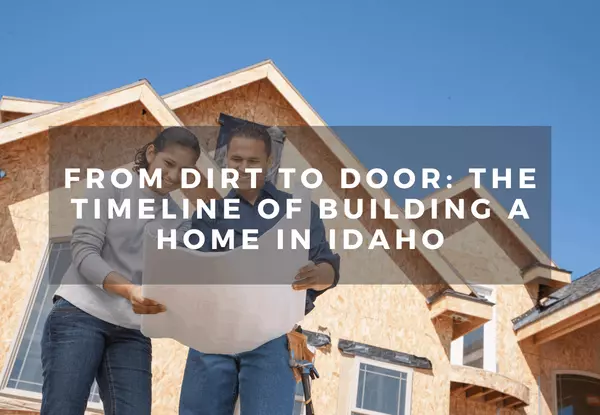Winterizing Your Treasure Valley Home: Cold Weather Preparation Guide (2025 Edition)

Every year, as fall turns to winter in the Treasure Valley, we experience that familiar drop in temperature that tells us—it’s time to get our homes ready. Whether you’re in Boise, Eagle, Meridian, Star, Nampa, or Kuna, the freezing temps, snowstorms, and fluctuating weather patterns can take a toll on your property if you're not properly prepared.
As a real estate professional who helps buyers and sellers throughout the Treasure Valley, and as someone with a construction background, I want to walk you through practical winter prep strategies that not only protect your home but also improve energy efficiency and peace of mind.
Why Winterizing Matters in the Treasure Valley
While Idaho winters may not rival Montana or Minnesota, they can still bring sub-zero temps, heavy snow in the foothills, icy mornings, and freezing rain. Cold snaps in January and February are especially brutal on plumbing, roofs, and HVAC systems. Neglecting winter prep can lead to frozen pipes, energy loss, and even costly emergency repairs.
Here in the Treasure Valley, we get the full winter spectrum: high desert cold, sunshine, ice storms, and early thaws. That means your home needs a flexible and reliable defense system to hold up through it all.
Exterior Maintenance: Your First Line of Defense
1. Gutters and Downspouts
-
Clean out all leaves, pine needles, and debris.
-
Make sure downspouts are extended at least 3 feet away from the foundation.
-
Check for sagging or leaks—ice dams form quickly in clogged or damaged gutters.
2. Roof Inspection
-
Look for damaged, missing, or curling shingles.
-
Check flashing around chimneys and vents.
-
Clear branches hanging over the roof to avoid ice buildup or falling limbs.
3. Sprinkler Blowout
-
Hire a professional to blow out your irrigation system.
-
This is critical in areas like Eagle and Meridian where freezing lines can cause underground pipe damage.
4. Garden Hoses and Outdoor Faucets
-
Disconnect all hoses and store them indoors.
-
Shut off exterior valves from the inside, then open faucets to drain.
-
Install faucet covers or insulated socks.
5. Driveways and Walkways
-
Fill in cracks before moisture and freezing temps cause expansion damage.
-
Have de-icer on hand—magnesium chloride is pet-safe and effective below 0°F.
Freeze Protection: Preventing Plumbing Disasters
1. Locate Your Main Shut-Off Valve
Know where it is before you need it in an emergency. Most are in the basement, crawlspace, or near the water heater.
2. Insulate Exposed Pipes
-
Use pipe sleeves or foam insulation in crawlspaces, garages, and attics.
-
Pay attention to plumbing near exterior walls, especially in older Nampa or Caldwell homes.
3. Leave Cabinet Doors Open
-
For sinks on exterior walls, open cabinet doors at night to let warm air in.
4. Drip Faucets During Cold Snaps
-
In extended sub-freezing weather, a slow drip prevents pressure buildup in pipes.
HVAC Prep: Heating Without Wasting Energy
1. Furnace Checkup
-
Schedule a professional inspection and tune-up.
-
Replace filters every 1–3 months.
2. Smart Thermostats
-
A programmable thermostat can lower your heating bill by adjusting temps automatically.
-
Keep it at 68°F when home, 62°F when away.
3. Seal Duct Leaks
-
Leaky ducts can waste 20–30% of your heated air.
-
Use foil tape or hire a pro to pressure test.
4. Fireplace Prep
-
Clean out ashes and inspect the flue.
-
Consider a chimney sweep if it's been over a year.
Interior Comfort: Sealing, Insulating, and Saving Money
1. Weatherstripping and Caulking
-
Check around doors and windows.
-
Replace worn-out weatherstripping and seal gaps with exterior-grade caulk.
2. Attic Insulation
-
Idaho code recommends R-38 (about 12–14 inches).
-
Heat rises, so this is one of the highest ROI upgrades.
3. Window Coverings
-
Use thermal curtains or cellular blinds for insulation.
-
Open blinds during sunny days to let in free heat.
4. Door Sweeps
-
Install door sweeps on all exterior entries to block drafts.
Garage and Workshop Tips
1. Insulate Garage Doors
-
Especially if you have living space above or use it for storage.
2. Seal the Threshold
-
Prevent cold air from seeping in under the door.
3. Space Heater Safety
-
Only use UL-certified heaters with tip-over protection.
-
Keep them away from flammable materials.
Snow and Ice Equipment Checklist
-
Snow shovel or snowblower (with fuel)
-
De-icer (pet-safe, driveway-safe)
-
Roof rake (especially for low-pitched roofs)
-
Generator (with fuel and a maintenance check)
-
Flashlights and extra batteries
-
Emergency water and food supply (72-hour kit)
Bonus Tips for New Construction Homes
If you just closed on a new construction home in Kuna, Middleton, or Meridian:
-
Ask the builder where your shutoff valves and hose bib shutoffs are.
-
Your home may be energy efficient, but check for missing insulation or unsealed outlets.
-
Check window flashing and weatherstripping—new doesn’t always mean perfect.
Final Thoughts From Curtis
Winter doesn’t have to be stressful when your home is properly prepared. I see firsthand what can happen when things go wrong—like a frozen pipe burst in a $1M home or emergency HVAC repair during a blizzard weekend.
Taking 1–2 days in late October or early November to winterize your Treasure Valley home can save you thousands of dollars, lower your heating bills, and keep your family safe and comfortable.
If you’re not sure what to prioritize, I’m happy to connect you with trusted pros, plumbers, or energy consultants across the Valley.
Stay warm, stay prepared, and if you ever need real estate help—whether buying, selling, or just navigating Idaho winters—I’m here for you.
📲 Call or text Curtis Chism at (208) 510-0427
📥 Ready to relocate remotely? Download our Boise Relocation Guide
Categories
Recent Posts










